Tepuy or
Tepui
Sir Walter Raleigh described
what was possibly a tepuy (table top mountain), and he is sometimes
said to have discovered Angel Falls, but these claims are considered
"far-fetched". They
were spotted in 1912 by the Venezuelan explorer Ernesto Sanchez La
Cruz, but he did
not publicise his discovery. They were not known to the outside world until
American aviator Jimmie Angel flew over them on the 16th of November 1933 on a flight while he was
searching for a valuable ore bed.
Returning on the 9th of October
1937, Angel tried to land his Flamingo monoplane "El Rio Caroni" atop
Auyan-tepui, but the plane was damaged when the wheels
sunk into the marshy ground, and he and his three companions, including his wife
Marie, were forced to descend the tepui on foot. It took them 11 days to make
their way back to civilization, but news of their adventure spread, and the
waterfall was named "Angel Falls" in his honour.
The most famous tepuis in the
park are Mount Roraima, the tallest and easiest to climb, and Auyantepui, from which fall the Angel Falls, the highest waterfall in the world. The tepuis are
sandstone and date back to a time when South America and Africa were part of a
super-continent.
The park is home to indigenous
Pemon Indians, part of the Carib linguistic group. The Pemon have an intimate relationship with the
tepuis, and believe they are the home of the 'mawari' spirits.
The park is relatively remote, with only a few roads connecting towns. Most
transport within the park is done by light plane from the airstrips built by
various Capuchin missions, or by foot and
canoe.
The main inhabitants are
the Pemons, they have developed some basic and luxurious hotel locations which
is mainly visited by European tourists.
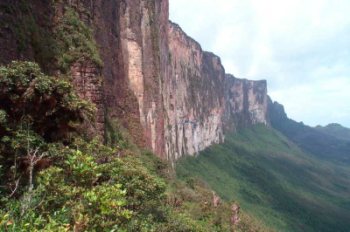
The plateau of
Mount Roraima. The peculiar rock formation is caused by erosion.
These table-top mountains are the
remains of a large, sandstone plateau that once covered the granite basement
complex between the north border of the Amazon Basin and the Orinoco, between the Atlantic coast and the Rio
Negro. Throughout the course of the history of Earth, the plateau was eroded, and the tepuis were formed from the
remaining monadnocks. There are
one hundred and fifteen such mesas in the Gran Sabana in the south-east of Venezuela on the border with Guyana and
Brazil, where the highest concentration of tepuis
is found. The precipitous mountains tower over the surrounding area by up to 1,000 metres. On the top of
the mountains grow various types of forests with a wide variety of
orchids and bromeliad
species. Because of their great age, some tepuis
exhibit surface features and subsurface caves that are typical of more water-soluble rock such as
limestone. Caves here include the six hundred and seventy one metre deep
Abismo Guy Collet, the
deepest quartzite cave in the world. Some of the mesas are pocked with giant
sinkholes up to three
hundred metres in diameter and with sheer walls up to three hundred metres
deep. These sinkholes are formed when the roofs of tunnels carved by underground
rivers collapse. Ptari Tepui's
sheer rock walls are so isolated, it is believed a high number of endemic plant and animal
species could be found there. Sarisarinama Tepui, famous for its almost perfectly
circular sinkholes which go straight down from the mountain top - the largest
such sinkhole is three hundred and fifty metres in diameter and depth
(purportedly created by groundwater erosion). They harbour an ecosystem composed
of unique plant and animal species at the
bottom.
Flora and fauna
The plateau of the
mesas is completely isolated from the ground forest, making them
ecological islands. The altitude causes them to have a
different climate from the ground forest. The top presents cool temperatures
with frequent rainfall, while the bases of the mountains have a tropical, warm
and humid climate. The isolation has led to the presence of
endemic flora and fauna through evolution over millennia of a different
world of animal and plants, cut off from the rest of the world by the imposing
rock walls. Some tepui sinkholes contain species that have evolved in these
"islands within islands" that are unique to that sinkhole. The tepuis are often
referred to as the Galapagos Islands of the mainland, having a large number of unique plants and animals
not found anywhere else in the world. The floors of the mesas are poor in
nutrients, which has led to a rich variety of carnivorous plants. The weathered, craggy nature of the rocky ground means no layers of
humus are formed. The tepuis, also known as
'islands above the rainforest', are a challenge for researchers, as they are
home to a high number of new species which have yet to be
described. A few of these
mountains are cloaked by thick clouds almost the whole year round. Their
surfaces could previously only be photographed by helicopter radar equipment.
Humans have still yet to set foot on many of the tepuis.
Most tepuis are in the Canaima National
Park which has been
classified as a World Heritage Site by UNESCO.
A few of the most notable of
the Tepuis:
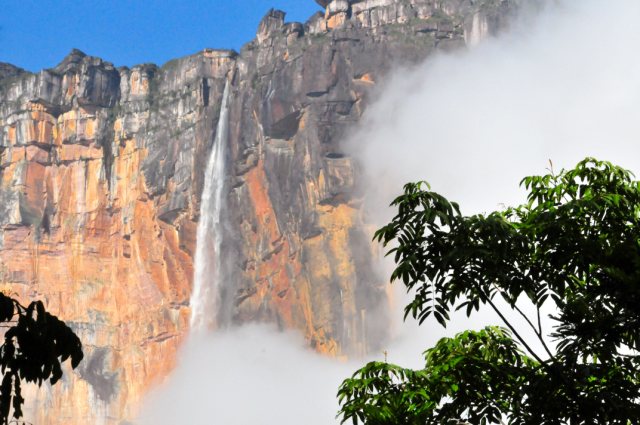
Auyan-tepui is the largest of the tepuis with a
surface area of 700 km². Angel Falls drops from a cleft in the
summit.
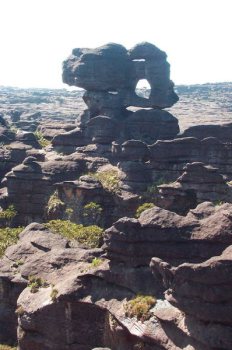
Mount Roraima, also known as Roraima
Tepui. A report by the noted South American researcher Robert
Schomburgk inspired the Scottish author Arthur Conan
Doyle to write his novel The Lost World about the discovery of a living prehistoric world full of dinosaurs
and primeval plants. The borders of Venezuela, Brazil and Guyana meet on the
top.
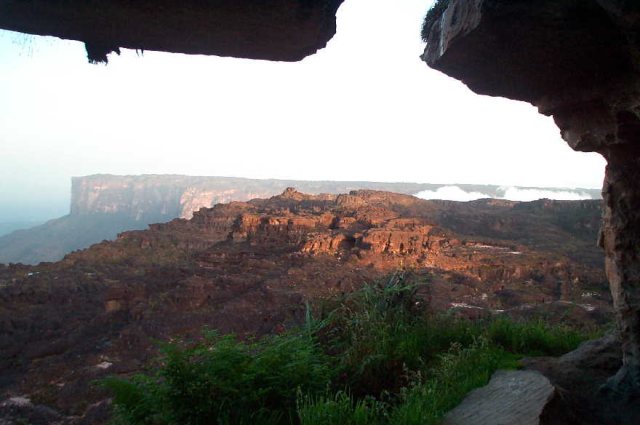
Matawi Tepui, also known as Kukenan, because it is the source of the Kukenan River, is
considered the "place of the dead" by the local Pemon Indians. Located next to Mount Roraima in
Venezuela.
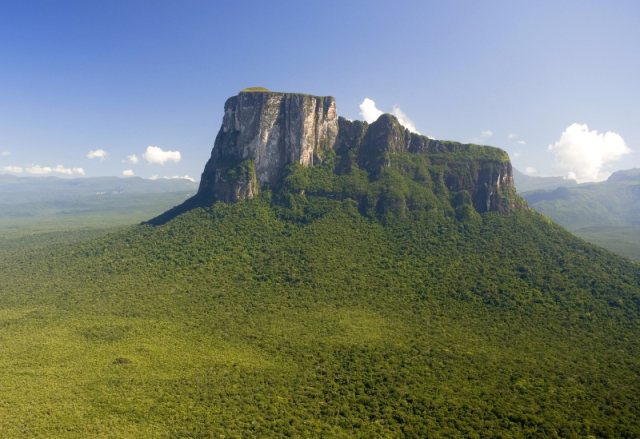
Autana
Tepui stands one thousand three
hundred metres above the forest floor. A unique cave runs from one side of the mountain to the
other.
ALL IN ALL
STUNNING IN THEIR NATURAL BEAUTY.
THE LOST WORLD SPRUNG TO MIND - NOTHING THE LIKE I HAD EVER SEEN
BEFORE
|





